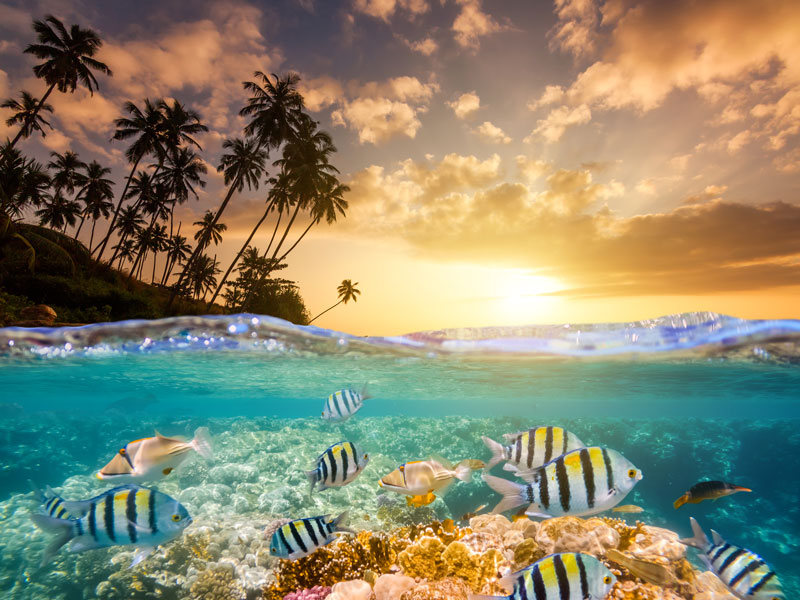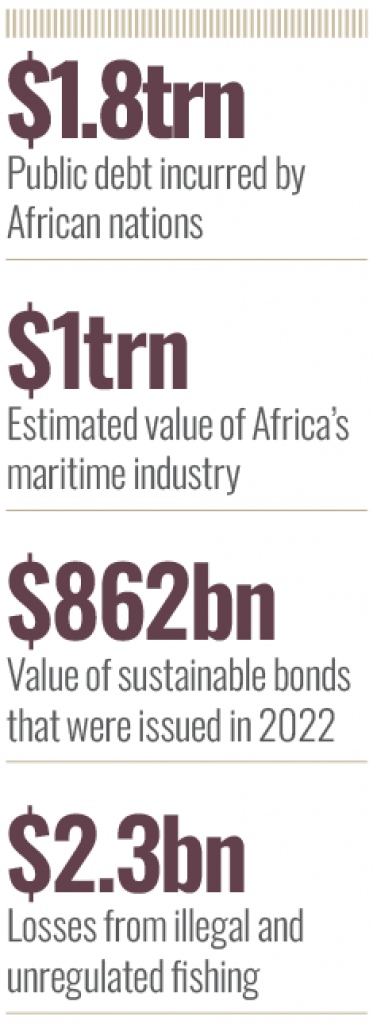
 
Finance marine conservation and long-term sustainability efforts, writes John Muchira”/>
African international locations are in dire want of huge sources to Finance sustainable improvement. Having amassed a staggering $1.8trn in public debt over the previous twenty years to Finance infrastructure tasks, most nations have restricted headroom for typical borrowing. For that reason, international locations are being pressured to develop into artistic and modern in mobilising sources.
In October, as an example, Egypt raised $478m by way of a Chinese language yuan-denominated panda bond, a primary by a Center East and Africa sovereign. Aside from diversifying its financing sources, the first goal was to flee from excessive rates of interest within the west contemplating the three-year bond got here with an rate of interest of three.5 %.
Two months earlier in August, Gabon turned solely the second African nation to subject a blue bond after Seychelles, which in 2018 had debuted the world’s first blue bond, elevating $15m. Within the case of Gabon, the ‘debt-for-nature swap’ resulted in refinancing $500m of its public debt and unlocking some $163m for marine conservation. The long-term blue bond, which matures in 2038, got here with a coupon priced at 6.097 %. This was decrease than the coupons on the repaid bonds, which have been between 6.625 % to seven %.
“Blue bonds maintain lots of promise,” says Sally Yozell, Director of the Environmental Safety Program of the Stimson Heart. She provides that Seychelles paved the best way for different African nations to undertake blue bonds issuances, together with steps for achievement.
Granted, the debt conversion for ocean conservation in Gabon that got here with the tag of a ‘blue bond’ has raised debate over legitimacy. The truth that Gabon’s sole objective in floating the bond was to refinance its money owed has introduced in regards to the query on whether or not ‘blue’ bonds are being abused as a substitute of the proceeds being ring-fenced for safeguarding and managing the marine ecosystem. The central African nation purchased again three bonds, one maturing in 2025 and two in 2031, with a complete nominal worth of $500m. The buybacks have been equal to round 4 % of the nation’s whole debt.
Conservation money
Simone Utermarck, Sustainable Finance Director on the Worldwide Capital Market Affiliation (ICMA), explains that for blue bonds, the proceeds or an equal quantity ought to completely be utilized to Finance or refinance, partially or in full, new and/or current eligible inexperienced/blue tasks. “Gabon is a debt for nature swap, not a use of proceeds bond,” she states.
A month after the Gabon issuance, which was organized by the Financial institution of America and fronted by US-based The Nature Conservancy (TNC) that has arrange offers value a minimum of $1bn, ICMA revealed a ‘practitioner’s information.’ The target was to supply issuers with steering on the important thing elements concerned in launching a ‘credible’ blue bond and help underwriters by providing important steps that facilitate transactions that protect the ‘integrity’ of the market.
Away from the legitimacy debate, the consensus is that blue bonds can supply African nations with coastlines a viable supply for mobilising sources for conservation. Undoubtedly, Africa’s oceans and waterways are in peril. Wanton air pollution, local weather change, overfishing, unlawful fishing and poor administration, amongst different components, are threatening to wipe out the socio-economic advantages that come from the water our bodies. Unlawful, unreported and unregulated (IUU) fishing alone prices Africa over $2.3bn in financial losses yearly, in accordance with estimates from the African Union Fee.
The significance of Africa’s blue economic system can’t be underestimated. Yearly, IT generates roughly $300bn, creating 49 million Jobs in sectors like tourism, transportation, fisheries and aquaculture. Cumulatively, the annual worth of Africa’s maritime trade is estimated to be over $1trn. Marine sources, significantly fisheries, underpin the continent’s sustainable blue economic system in addition to the meals, financial and ecological safety of a whole bunch of hundreds of thousands of individuals. Fish signify over 20 % of whole protein consumption in 20 international locations, accounting for roughly 200 million folks. In some international locations like Sierra Leone and Senegal, IT accounts for over 70 % of protein consumption.
Nicholas Hardman-Mountford, Head of Oceans and Pure Assets on the Commonwealth Secretariat, contends that as populations develop and the demand for marine sources will increase, Africa should prioritise conservation. “For Africa, IT’s about making certain a sustainable future for its folks,” he notes. He provides that the Commonwealth has even developed a Blue Constitution to assist African international locations harness their marine wealth sustainably. Amongst different issues, the constitution recognises the potential of modern financing mechanisms like blue bonds to Finance marine conservation.
World development
Although nonetheless in its nascent levels globally, the blue bonds market is increasing. Based on the Stimson Heart, 26 blue bonds have been issued between 2018 and 2022 amounting to a complete worth of $5bn. This represented a 92 % compound annual development charge. Latin America and South Asia are two areas the place the blue bond market is especially vibrant and modern. “The growing presence of main multilateral improvement banks and monetary establishments will doubtless assist the expansion of the blue bonds market,” avers Yozell, including that the launch of the world’s first blue bond index in July this yr is sure to speed up development.
Notably, the road between blue bonds and inexperienced, social and sustainability bonds is changing into extraordinarily skinny. In 2022, the worldwide issuance quantity throughout the entire spectrum of sustainable bonds amounted to $862bn, dropping from a document excessive of $1trn in 2021. The market is forecast to bounce again, with ICMA stating that 98 % of whole sustainable bonds issued globally are aligned with its ideas. “Within the final 5 years, a collection of blue bond issuances exhibit a rising urge for food for ocean-themed bonds,” notes Utermarck.
For blue bonds, ICMA has designated eight classes that qualify for financing by way of proceeds of blue bonds. These embody coastal local weather adaptation and resilience, marine ecosystem administration, conservation and restoration, marine air pollution and marine renewable vitality. Others are sustainable coastal and marine tourism, sustainable marine worth chains, sustainable ports and sustainable marine transport. “Because the issuance of blue bonds turns into extra vibrant in varied elements of the world, Africa has a singular alternative to study, adapt and implement these monetary mechanisms to attain each financial and environmental sustainability,” observes Hardman-Mountford.
A blueprint for bonds
Seychelles and Gabon have set a precedent. For each international locations, issuing blue bonds was a no brainer. Within the case of Seychelles, marine sources are vital to its economic system. After tourism, fisheries is the second most vital sector, contributing 20 % of the gross home product and using 17 % of the inhabitants. Fish merchandise account for about 95 % of the full worth of home exports.
Seychelles paved the best way for different African nations to undertake blue bonds issuances
As one of many world’s biodiversity hotspots, marine conservation is a matter of survival for the archipelagic nation of 115 granite and coral islands. This explains why Seychelles floated a blue bond with proceeds from the 10-year bond going in the direction of the growth of marine protected areas, enhancing governance of precedence fisheries and the event of the blue economic system. The federal government additionally arrange funds to supply grants and loans to organisations and corporations concerned in marine conservation. Gabon, on its half, additionally must prioritise safety of its seashores and coastal waters as a matter of urgency. Aside from shedding roughly $610m yearly to IUU, the nation hosts the world’s largest inhabitants of leatherback turtles, as a lot as 30 % of the worldwide inhabitants of the endangered species. IT can be residence to one of many largest olive ridley turtle rookeries within the Atlantic, and to the Atlantic humpback dolphin, just lately categorised as critically endangered.
To guard these species from extinction and protect sustainability of its coastal waters, the nation intends to deploy the $163m raised from the blue bond to Finance a brand new marine spatial plan, enhance administration in present marine protected areas, strengthen enforcement towards IUU fishing and help a sustainable blue economic system. Tragically for the nation, implementation of those measures now hangs within the steadiness following a coup that ousted long-serving President Ali Bongo simply days after the bond issuance. “The experiences of Seychelles and Gabon present beneficial insights and inspiration for different African international locations,” says Hardman-Mountford. The continent has 38 coastal states and plenty of island states like Cape Verde, Sao Tomé and Principe, Mauritius, Seychelles and the Comoros. Collectively, Africa’s coastal and island states embody huge ocean territories of an estimated 13 million sq. kilometres.
Blue bond buoyancy
Going ahead, little question extra African international locations will flip to the worldwide monetary markets to drift blue bonds to Finance marine conservation. Nevertheless, the extent of sophistication, excruciating and complicated processes, market situations and different components, each inside and exterior, imply that issuing a blue bond isn’t plain crusing. Presently, as an example, the excessive rates of interest in western capital markets pushed by the US Fed’s coverage stances outlined by intensive tightening cycles implies that sovereigns have to be able to bear the burden of excessive rates of interest.
“The success of blue bonds requires meticulous planning, widespread stakeholder engagement and an unwavering dedication to transparency and long-term marine conservation targets,” notes Hardman-Mountford.
For blue bonds, the bar for scrutiny has been raised following Gabon’s debt-for-nature swap issuance and the truth that TNC has confronted criticism for utilizing the ‘blue bond’ tag to assist refinance greater than $1.2bn of debt globally whereas producing solely $400m for conservation. Going ahead, regulators and traders are sure to demand extra readability.